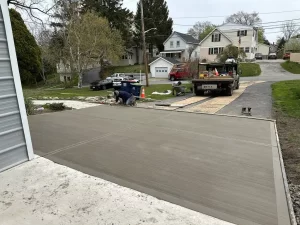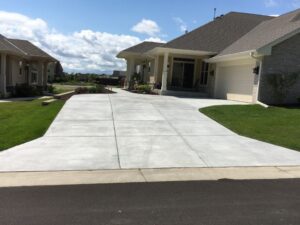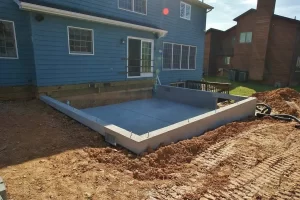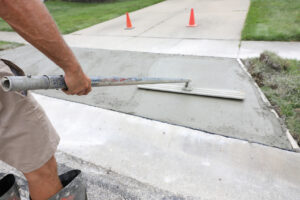Composite decking is an innovative and eco-friendly decking option crafted from a blend of recycled materials, including wood fibers and plastic. It offers the natural look of wood with the added durability and minimal maintenance of plastic, making it an increasingly popular choice for homeowners looking to enhance their outdoor spaces. This innovative decking solution offers an attractive and practical alternative to traditional wood, blending aesthetics with functionality to transform outdoor areas into durable, stylish spaces. Composite decking's resilience against the elements and everyday use means it can withstand the test of time, providing a beautiful outdoor setting for entertainment, relaxation, and family gatherings without the constant need for maintenance. Whether you're upgrading an existing deck or embarking on a new project, composite decking offers a versatile, environmentally friendly, and cost-effective solution that caters to a wide array of design preferences and functional requirements.
Understanding Composite Decking: A Comprehensive Overview
Composite decking represents the cutting-edge in outdoor flooring solutions, seamlessly blending aesthetic appeal with unparalleled functionality. Unlike traditional decking materials, composite decking withstands the rigors of outdoor conditions without the need for frequent upkeep. This makes it an ideal option for those seeking a balance between the timeless beauty of wood and the convenience of modern materials. Its versatility in design and color options allows it to fit a wide range of architectural styles, ensuring that every homeowner can find the perfect match for their outdoor aesthetic.
Composite Decking Materials: The Core Components Explained
At the heart of composite decking's appeal is its unique composition. The boards are made from a mix of recycled wood and plastic materials, including recycled plastic and wood chips or fibers. This not only contributes to the environmental benefits of using composite materials but also enhances the durability and lifespan of the decks themselves. The process of combining these materials under high pressure and temperature results in composite decking boards that are not only eco-friendly but also extremely resistant to the elements and everyday wear and tear.
The Role of Woods and Materials in Composite Decks
The selection of woods and materials in composite decks plays a crucial role in achieving the desired quality and performance. High-quality hardwood fibers are carefully blended with durable plastic materials to create composite boards that offer the best of both worlds. This combination results in decks that are not only robust and long-lasting but also bear the natural beauty and warmth of wood. The use of recycled materials further underscores the sustainability aspect, making composite decking an environmentally responsible choice for outdoor living spaces.
Natural Wood vs. Composite Decking: A Comparison
The debate between natural wood and composite decking centers on several key factors, including cost, maintenance, and environmental impact. While natural wood decks have been the traditional choice for their natural beauty and initial affordability, they require significant maintenance to keep them looking their best. Composite decking, on the other hand, offers a compelling alternative with its blend of wood fibers and recycled plastic, offering the aesthetic appeal of wood without the high maintenance demands. This makes composite decking a more cost-effective and environmentally friendly option over the long term.
Pressure-Treated Wood and Its Place in Deck Construction
Pressure-treated wood has long been valued in deck construction for its affordability and resistance to decay and insects. However, it requires regular maintenance to protect against weathering and wear. In contrast, composite decking emerges as a superior choice for those looking for a more durable and low-maintenance alternative. Though the initial investment in composite decking may be higher, the savings in maintenance costs and the longer lifespan make it a more economical choice over time.
The Benefits of Choosing Composite Woods for Your Deck
Choosing composite woods for your deck construction not only enhances the aesthetic appeal of your outdoor space but also offers several practical benefits. These include:
- Environmental Sustainability:
- Made from recycled materials, including wood chips and plastic, reducing waste.
- Contributes to conservation efforts by minimizing the need for new timber.
- Durability and Longevity:
- Highly resistant to fading, staining, and scratching.
- Does not warp, crack, or splinter over time, unlike traditional wood.
- Low Maintenance:
- Requires minimal maintenance, with no need for annual staining or sealing.
- Easy to clean with just soap and water, saving time and maintenance costs.
- Safety and Comfort:
- Composite decks do not splinter, making them safer for bare feet and pets.
- Many products offer slip-resistant surfaces for additional safety.
- Aesthetic Versatility:
- Available in a wide range of colors and textures to match any home exterior.
- Offers the look and feel of real wood without the associated upkeep.
- Increased Property Value:
- Enhances the overall appeal and functionality of outdoor spaces.
- Can improve the resale value of your home due to its durability and low maintenance features.
Choosing composite decking for your home is not just a choice for a better deck; it's a decision towards a more sustainable, maintenance-free, and beautiful outdoor living space.
Resistance Features: Water, Insect Damage, and Slip Resistance
Composite decking is engineered to resist the common pitfalls that afflict wood decks, including water damage, insect infestation, and slippery surfaces. These boards are designed to absorb less moisture, significantly reducing the risk of mold and mildew growth. Moreover, the composite material is impervious to insect damage, ensuring that your deck remains strong and intact year after year. Many composite decking options also feature slip-resistant surfaces, making them a safer choice for wet conditions and high-traffic areas.
The Appearance and Feel of Wood Composite Decks
Despite being made from a mix of wood and plastic, composite decks offer the appearance and feel of real wood. Advanced manufacturing techniques allow for a wide range of textures and colors, mimicking the look of various hardwoods and providing homeowners with the option to choose the perfect shade and grain pattern to complement their outdoor space. The result is a deck that combines the natural charm and warmth of wood with the durability and ease of maintenance of synthetic materials.
Composite Decking vs. Wood Decking: Evaluating Cost and Value
When evaluating the cost and value of composite versus wood decking, it's important to consider not only the initial installation costs but also the long-term expenses associated with maintenance. While wood decking may have a lower upfront cost, the ongoing need for staining, sealing, and repairs can add up, making wood decking more expensive over its lifetime. Composite decking, with its higher initial investment, ultimately offers better value through its minimal maintenance requirements and longer lifespan. This means homeowners can enjoy their beautiful deck for years to come without the worry of frequent upkeep or replacement costs. Furthermore, the consistent beauty and durability of composite decking can enhance the overall value of your home, making it a wise investment for both your outdoor living experience and your property's market appeal.




